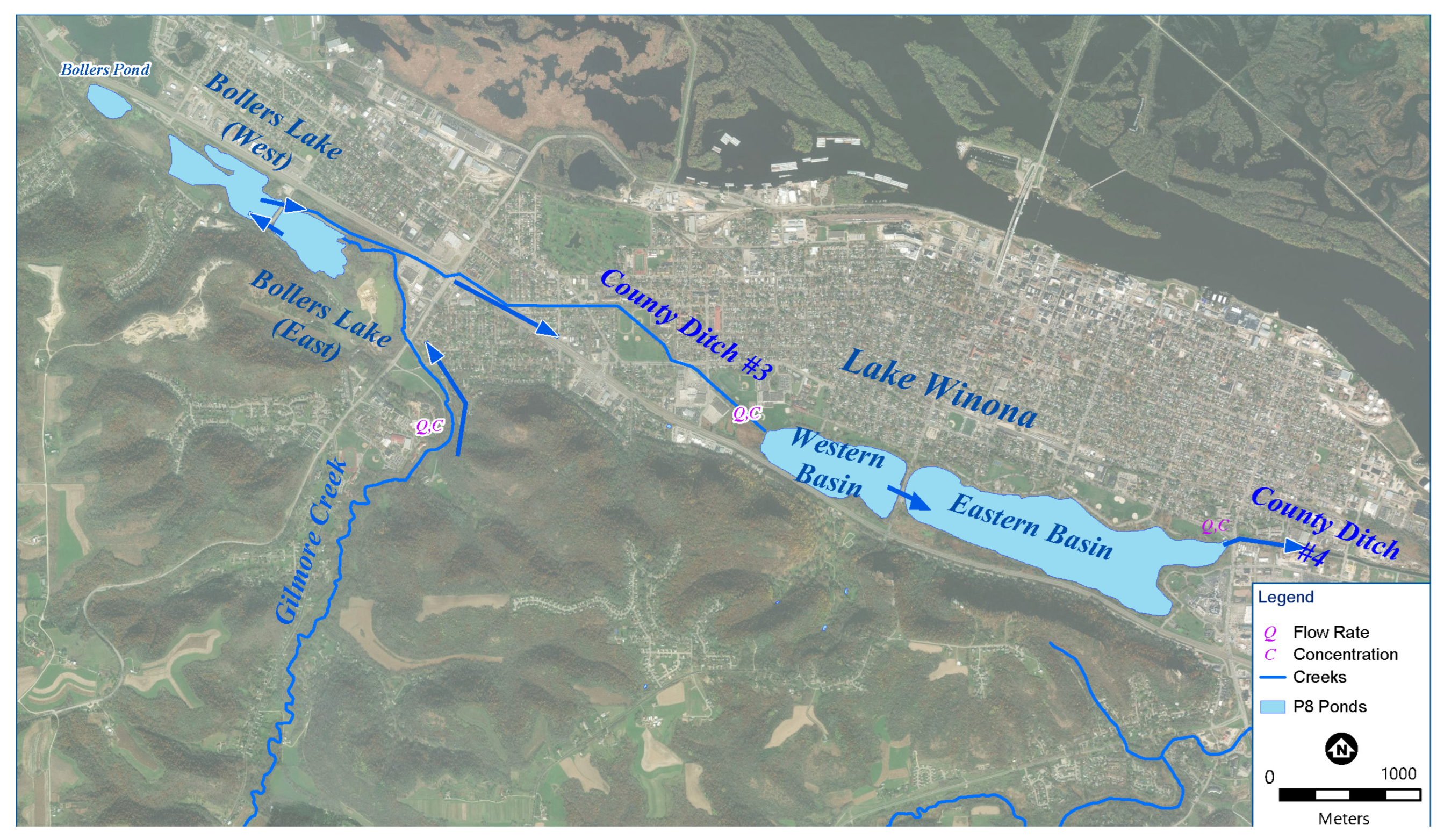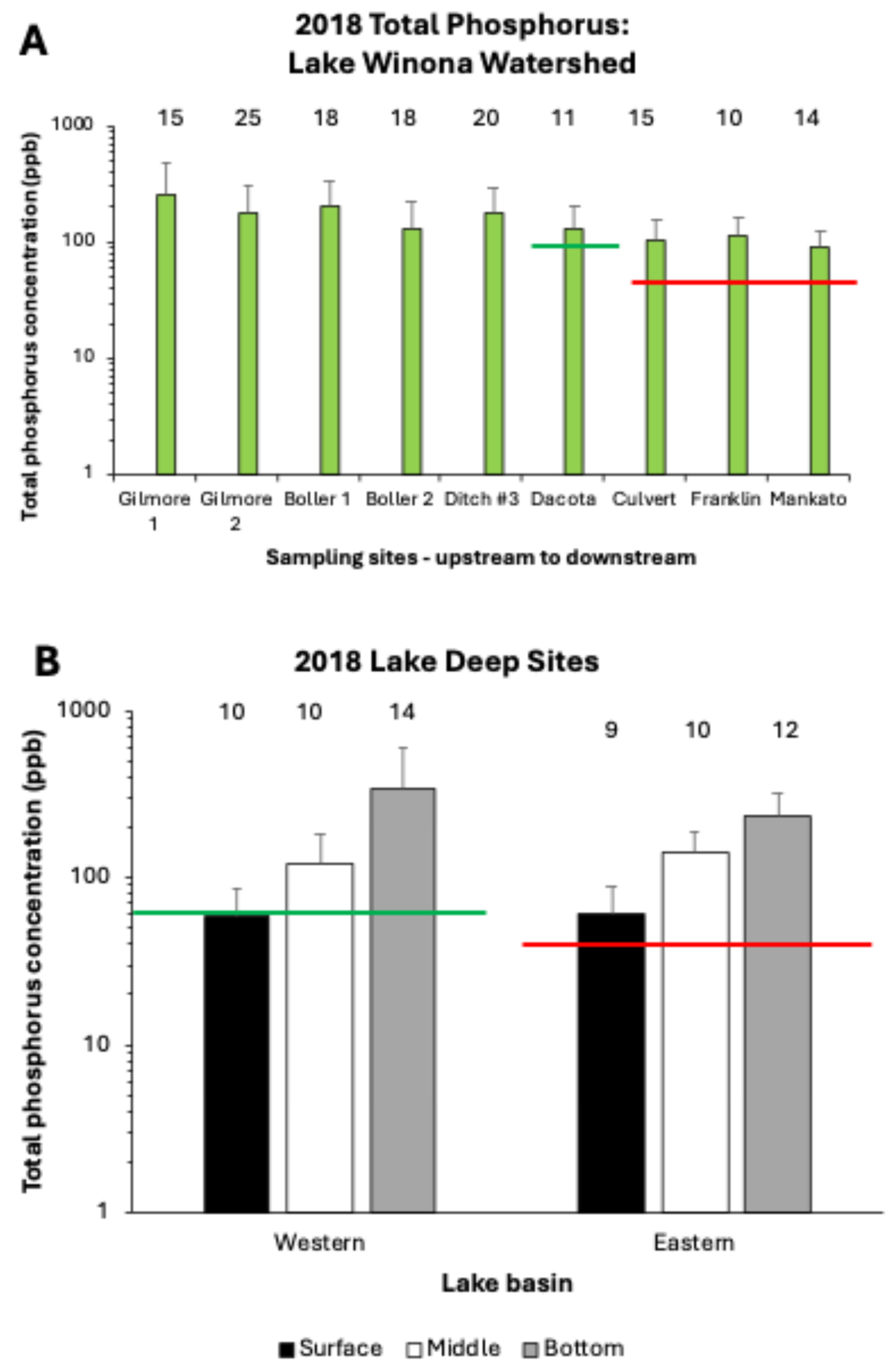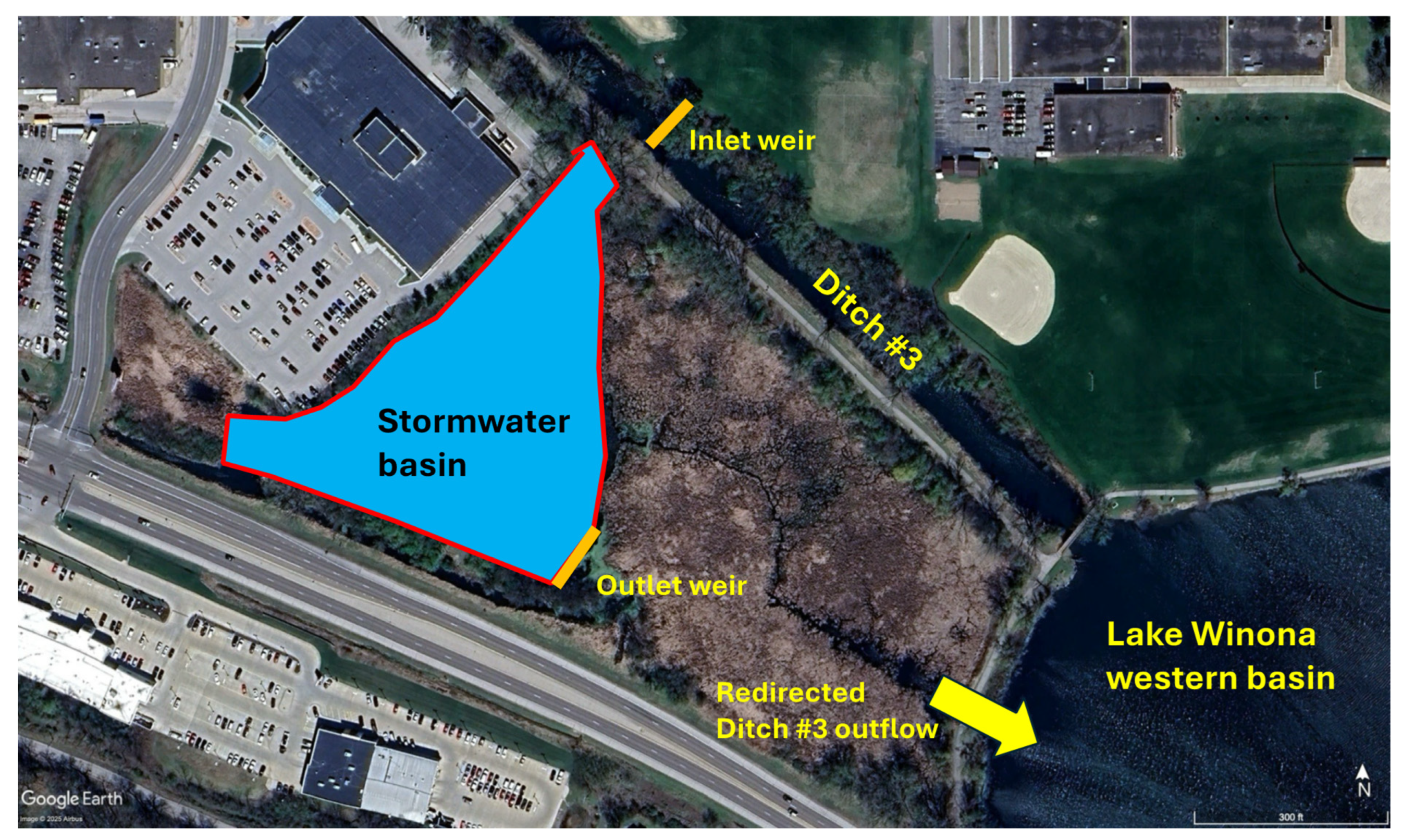Total Phosphorus Loadings and Corrective Actions Needed to Restore Water Quality in a Eutrophic Urban Lake in Minnesota, USA: A Case Study
Abstract
1. Introduction
2. Study Site: Lake Winona
3. Methods
3.1. Historical Phosphorus Data
3.2. 2016 TMDL for Lake Winona
3.3. Updated Lake Winona P Modeling and Assessment 2018–2020
4. Results
4.1. Historical Phosphorus Data Leading to Lake Impairment Listing
4.2. 2018 Phosphorus Data
4.3. 2016 Lake Winona BATHTUB Model TMDL
4.4. 2018–2020 Lake Winona P8 Model TMDL
4.5. Differences Between BATHTUB and P8 Models
4.6. Recommended Correction Actions to Reduce P Loading
5. Discussion and Evaluation of Recommended Corrective Actions for Reducing P Loading
5.1. In-Lake Alum Treatments
5.2. Common Carp Management
5.3. Stormwater Treatment Pond for Ditch #3/Lower Gilmore Creek
5.4. Iron-Enhanced Sand Filtration Basins—Eastern Basin
5.5. Collective Benefits and Costs
5.6. Implementing P-Reduction Recommendations
5.7. Success in Restoring P-Impaired Lakes in Minnesota
6. Conclusions
Author Contributions
Funding
Institutional Review Board Statement
Informed Consent Statement
Data Availability Statement
Acknowledgments
Conflicts of Interest
References
- United States Environmental Protection Agency. Summary of the Clean Water Act; United States Environmental Protection Agency: Washington, DC, USA, 2024. Available online: https://www.epa.gov/laws-regulations/summary-clean-water-act (accessed on 6 April 2025).
- United States Environmental Protection Agency. Identifying Polluted Waters and Developing Plans to Restore Them; United States Environmental Protection Agency: Washington, DC, USA, 2025. Available online: https://www.epa.gov/tmdl (accessed on 6 April 2025).
- Schindler, D.W.; Carpenter, S.R.; Chapra, S.C.; Hecky, R.E.; Orihel, D.M. Reducing phosphorus to curb lake eutrophication is a success. Environ. Sci. Technol. 2016, 50, 8923–8929. [Google Scholar] [CrossRef] [PubMed]
- Schindler, D.W. The dilemma of controlling cultural eutrophication of lakes. Proc. R. Soc. Lond. Ser. B 2012, 279, 4322–4333. [Google Scholar] [CrossRef] [PubMed]
- Bhagowati, B.; Ahamad, K.U. A review on lake eutrophication dynamics and recent developments in lake modeling. Ecohydrol. Hydrobiol. 2019, 19, 155–166. [Google Scholar] [CrossRef]
- Wang, H.; Wang, H. Mitigation of lake eutrophication: Loosen nitrogen control and focus on phosphorus abatement. Prog. Nat. Sci. 2009, 19, 1445–1451. [Google Scholar] [CrossRef]
- Carpenter, S.R. Phosphorus control is critical to mitigating eutrophication. Proc. Natl. Acad. Sci. USA 2008, 105, 11039–11040. [Google Scholar] [CrossRef]
- Oliveira, M.; Machado, A.V. The role of phosphorus on eutrophication: A historical review and future perspectives. Environ. Technol. Rev. 2013, 2, 117–127. [Google Scholar] [CrossRef]
- Liang, Z.; Soranno, P.A.; Wagner, T. The role of phosphorus and nitrogen on chlorophyll a: Evidence from hundreds of lakes. Water Res. 2020, 185, 116236. [Google Scholar] [CrossRef]
- Qin, B.; Zhou, J.; Gardner, W.S.; Deng, J.; Brookes, J.D. Water depth underpins the relative roles and fates of nitrogen and phosphorus in lakes. Environ. Sci. Technol. 2020, 54, 3191–33198. [Google Scholar] [CrossRef] [PubMed]
- Singer, P.C. Control of phosphate by iron. J. Water Pollut. Control Fed. 1972, 44, 663–669. [Google Scholar]
- Garrison, P.J.; Knauer, D.R. Long-term evaluation of three alum treated lakes. Lake Reserv. Manag. 1984, 1, 513–517. [Google Scholar] [CrossRef]
- Smeltzer, E.; Kirn, R.A.; Fiske, S. Long-term water quality and biological effects of alum treatment of Lake Morey, Vermont. Lake Reserv. Manag. 1999, 15, 173–184. [Google Scholar] [CrossRef]
- Rydin, E.; Huser, B.; Welch, E.B. Amount of phosphorus inactivated by alum treatments in Washington lakes. Limnol. Oceanogr. 2000, 45, 226–230. [Google Scholar] [CrossRef]
- Steinman, A.D.; Ogdahl, M. Ecological effects after an alum treatment in Spring Lake, Michigan. J. Environ. Qual. 2008, 37, 22–29. [Google Scholar] [CrossRef]
- Huser, B.; Brezonik, P.; Newman, R. Effects of alum treatment on water quality and sediment in the Minneapolis Chain of Lake, Minnesota, USA. Lake Reserv. Manag. 2011, 27, 220–228. [Google Scholar] [CrossRef][Green Version]
- Huser, B.J.; Futter, M.; Lee, J.T.; Perniel, M. In-lake measures for phosphorus control: The most feasible and cost-effective solution for long-term management of water quality in urban lakes. Water Res. 2016, 97, 142–152. [Google Scholar] [CrossRef] [PubMed]
- Brattebo, S.K.; Welch, E.B.; Gibbons, H.L.; Burghdoff, M.K.; Williams, G.N.; Oden, J.L. Effectiveness of alum in a hypereutrophic lake with substantial external loading. Lake Reserv. Manag. 2017, 33, 108–118. [Google Scholar] [CrossRef]
- Minnesota Pollution Control Agency. Mississippi River-Winona Watershed Pollutant Reduction Project (Total Maximum Daily Load Study) for Nutrients, Sediment and Bacteria; Minnesota Pollution Control Agency: Saint Paul, MN, USA, 2016.
- WHKS and Barr Engineering. Lake Winona Water Quality Improvement Plan: A Targeted, Prioritized, and Measurable Implementation Plan to Effectively Restore Lake Winona; Barr Engineering: Minneapolis, MN, USA, 2020. [Google Scholar]
- Fairbairn, D.J.; Trojan, M.D. Iron-enhanced sand filters: Multi-year urban runoff (stormwater) quality performance. Sci. Total Environ. 2023, 859, 160177. [Google Scholar]
- Erickson, A.J.; Gulliver, J.S.; Weiss, P.T. Capturing phosphates with iron enhanced sand filtration. Water Res. 2012, 46, 3032–3042. [Google Scholar] [CrossRef]
- Wen, D.; Chang, N.-B.; Wanielista, M.P. Assessing nutrient removal in stormwater runoff for urban farming with iron filings-based green environmental media. Sci. Rep. 2020, 10, 9379. [Google Scholar] [CrossRef]
- Huser, B.J.; Bajer, P.G.; Chizinski, C.J.; Sorensen, P.W. Effects of common carp (Cyprinus carpio) on sediment mixing depth and mobile phosphorus mass in the active sediment layer of a shallow lake. Hydrobiologia 2016, 763, 23–33. [Google Scholar] [CrossRef]
- Bodus, B.; McDonald, W. End-of-pipe filter to reduce phosphorus concentrations from the effluent of green infrastructure underdrains. J. Environ. Manag. 2025, 375, 124131. [Google Scholar] [CrossRef]
- Pilgrim, K.M.; Brezonik, P.L. Treatment of lake inflows with alum for phosphorus removal. Lake Reserv. Manag. 2005, 21, 1–9. [Google Scholar] [CrossRef]
- Pilgrim, K.M.; Brezonik, P.L. Evaluation of the potential adverse effects of lake inflow treatment with alum. Lake Reserv. Manag. 2005, 21, 77–87. [Google Scholar] [CrossRef]
- Fremling, C.R.; Heins, G.A. A Lake Winona Compendium: Information Concerning the Reclamation of an Urban Winter-Kill Lake at Winona, Minnesota, 2nd ed.; Winona State University: Winona, MN, USA, 1986. [Google Scholar]
- Mundahl, N.D.; Hoisington, J. Game fish response to dredging of a eutrophic urban lake in Minnesota. Lake Reserv. Manag. 2020, 37, 170–185. [Google Scholar] [CrossRef]
- City of Winona. Stormwater; City of Winona: Winona, MN, USA, 2025. Available online: https://www.cityofwinona.com/341/Stormwater (accessed on 8 April 2025).
- Minnesota Pollution Control Agency. Lakes and Streams Water Quality Dashboard, Winona: Northwest Bay; Minnesota Pollution Control Agency: Saint Paul, MN, USA, 2025. Available online: https://webapp.pca.state.mn.us/surface-water/impairment/85-0011-02 (accessed on 9 April 2025).
- Minnesota Pollution Control Agency. Lakes and Streams Water Quality Dashboard, Winona: Southeast Bay; Minnesota Pollution Control Agency: Saint Paul, MN, USA, 2025. Available online: https://webapp.pca.state.mn.us/surface-water/impairment/85-0011-01 (accessed on 9 April 2025).
- Walker, W.; Walker, J. P8 Urban Catchment Model: Program for Predicting Polluting Particle Passage thru Pits, Puddles, and Ponds. 17 January 2017. p8. Available online: https://www.wwwalker.net/p8/ (accessed on 8 April 2025).
- Canfield, D.; Bachman, R. Prediction of total phosphorus concentration, chlorophyll-a, and Secchi depths in natural and artificial lakes. Can. J. Fish. Aquat. Sci. 1981, 38, 414–423. [Google Scholar] [CrossRef]
- Forasté, J.A.; Goo, R.; Thrash, J.; Hair, L. Measuring the cost-effectiveness of LID and conventional stormwater management plans using life cycle costs and performance metrics. In Low Impact Development Technology: Implementation and Economics, Proceedings of the 2012 Ohio Stormwater Conference, Toledo, OH, USA, 6–8 June 2015; American Society of Civil Engineers: Reston, VA, USA, 2015. [Google Scholar]
- Horne, A.J.; Goldman, C.R. Limnology, 2nd ed.; McGraw-Hill, Inc.: New York, NY, USA, 1994. [Google Scholar]
- Wetzel, R.G. Limnology: Lake and River Ecosystems, 3rd ed.; Academic Press: San Diego, CA, USA, 2001. [Google Scholar]
- Welch, E.B.; Schrieve, G.D. Alum treatment effectiveness and longevity in shallow lakes. In Nutrient Dynamics and Biological Structure in Shallow Freshwater and Brackish Lakes. Developments in Hydrobiology; Mortensen, E., Jeppesen, E., Søndergaard, M., Nielsen, L.K., Eds.; Springer: Dordrecht, The Netherlands, 1994; Volume 94, pp. 423–431. [Google Scholar]
- Pilgrim, K.M.; Huser, B.J.; Brezonik, P.L. A method for comparative evaluation of whole-lake and inflow alum treatment. Water Res. 2007, 41, 1215–1224. [Google Scholar] [CrossRef]
- Henkelman, M.L.; Mundahl, N.D. Growth and condition of largemouth bass (Micropterus nigricans) and bluegill (Lepomis macrochirus) in a Minnesota, USA, lake with separate dredged and non-dredged basins. Limnol. Rev. 2024, 24, 235–249. [Google Scholar] [CrossRef]
- Diana, J.S. Biology and Ecology of Fishes, 2nd ed.; Cooper Publishing Group: Traverse City, MI, USA, 2004. [Google Scholar]
- Gao, J.; Dai, Q.; Fei, Q.; Guo, F.; Miao, T.; Zhang, H.; Liao, M.; Wang, H. Common carp Cyprinus carpio L. weaking the activity of two commonly used water-clearing agents for lake eutrophication control: A mesocosm study. Appl. Ecol. Environ. Res. 2025, 23, 915–924. [Google Scholar] [CrossRef]
- Bartodziej, W.; Sorensen, P.W.; Bajer, P.G.; Pilgrim, K.; Blood, S. A Minnesota story: Urban shallow lake management. Lakeline 2017, 37, 23–29. [Google Scholar]
- Benito, J.; Benejam, L.; Zamora, L.; García-Berthou, E. Diel cycle and effects of water flow on activity and use of depth by common carp. Trans. Am. Fish. Soc. 2015, 144, 491–501. [Google Scholar] [CrossRef]
- Chumchal, M.M.; Drenner, R.W. Interrelationships between phosphorus loading and common carp in the regulation of phytoplankton biomass. Arch. Hydrobiol. 2004, 161, 147–158. [Google Scholar] [CrossRef]
- Mundahl, N.D.; Schnaser, A.C.; Kluzak, C.M.; Henkelman, M.L. Common carp (Cyprinus carpio) reinvasion and population expansion in Lake Winona: A modified urban floodplain lake in Minnesota, USA. Water 2024, 16, 2571. [Google Scholar] [CrossRef]
- Bajer, P.G.; Beck, M.W.; Cross, T.K.; Koch, J.D.; Bartodziej, W.M.; Sorensen, P.W. Biological invasion by a benthivorous fish reduced the cover and species richness of aquatic plants in most lakes of a large North American ecoregion. Glob. Change Biol. 2016, 22, 3937–3947. [Google Scholar] [CrossRef]
- Bajer, P.G. A decade of common carp research and management in Minnesota. Lakeline 2017, 37, 43–48. [Google Scholar]
- Vilizzi, L.; Tarkan, A.S.; Copp, G.H. Experimental evidence from causal criteria analysis for the effects of common carp Cyprinus carpio on freshwater ecosystems: A global perspective. Rev. Fish. Sci. Aquac. 2015, 23, 253–290. [Google Scholar] [CrossRef]
- Lechelt, J.D.; Bajer, P.G. Elucidating the mechanism underlying the productivity-recruitment hypothesis in the invasive common carp. Aquat. Invasions 2016, 11, 469–482. [Google Scholar] [CrossRef]
- Schaus, M.H.; Vanni, M.J.; Wissing, T.E.; Bremigan, M.T.; Garvey, J.E.; Stein, R.A. Nitrogen and phosphorus excretion by detritivorous gizzard shad in a reservoir ecosystem. Limnol. Oceanogr. 1997, 42, 1386–1397. [Google Scholar] [CrossRef]
- Reddy, K.R.; Xie, T.; Dastgheibi, S. Nutrients removal from urban stormwater by different filter materials. Water Air Soil Poll. 2013, 225, 1778. [Google Scholar] [CrossRef]
- Erickson, A.J.; Gulliver, J.S.; Weiss, P.T.; Huser, B.J. Iron-enhanced sand filtration for stormwater phosphorus removal. In Proceedings of the 17th IAHR APD Congress, Auckland, New Zealand, 22–24 February 2010; Available online: https://www.iahr.org/library/infor?pid=10400 (accessed on 28 March 2025).
- Minnesota Pollution Control Agency. Phosphorus in Stormwater—Minnesota Stormwater Manual; Minnesota Pollution Control Agency: Saint Paul, MN, USA, 2023. Available online: https://stormwater.pca.state.mn.us/index.php?title=Phosphorus_in_stormwater (accessed on 3 April 2025).
- Kramer, D.B.; Polasky, S.; Starfield, A.; Palik, B.; Westphal, L.; Snyder, S.; Jakes, P.; Hudson, R.; Gustafson, E. A comparison of alternative strategies for cost-effective water quality management in lakes. Environ. Manag. 2006, 38, 411–425. [Google Scholar] [CrossRef] [PubMed]
- Hjerppe, T.; Väisänen, S. A practical tool for selecting cost-effective combinations of phosphorus loading mitigation measures in Finnish catchments. Int. J. River Basin Manag. 2015, 13, 363–376. [Google Scholar] [CrossRef]
- City of Winona. 2045 Comprehensive Plan: City of Winona; City of Winona: Winona, MN, USA, 2024. Available online: https://www.cityofwinona.com/DocumentCenter/View/5248/Winona-Comprehensive-Plan_JUNE2024_Final_Reduced?bidId= (accessed on 7 April 2025).
- Mundahl, N.D.; Howard, J. Rehabilitation and continuing management of an urban lake shoreline in southeastern Minnesota, USA. Land 2024, 13, 2224. [Google Scholar] [CrossRef]
- Fahnenstiel, G.L.; Lang, G.A.; Nalepa, T.F.; Johengen, T.H. Effects of zebra mussels (Dreissena polymorpha) colonization on water quality parameters in Saginaw Bay, Lake Huron. J. Great Lakes Res. 1995, 21, 435–448. [Google Scholar] [CrossRef]
- Bykova, O.; Laursen, A.; Bostan, V.; Bautista, J.; McCarthy, L. Do zebra mussels (Dreissena polymorpha) alter lake water chemistry in a way that favors Microcystis growth? Sci. Total Environ. 2006, 371, 362–372. [Google Scholar] [CrossRef] [PubMed]
- Cha, Y.; Stow, C.A.; Bernhardt, E.S. Impacts of dreissenid mussel invasions on chlorophyll and total phosphorus in 25 lakes in the USA. Freshw. Biol. 2013, 58, 192–206. [Google Scholar] [CrossRef]
- Strom, J.; Timm, A.; Anderson, J.; MacLean, S. Twenty years of lake nutrient impairment delistings in Minnesota. Lakeline 2024, 44-1, 9–13. [Google Scholar]
- Minnesota Pollution Control Agency. After More Than 20 Years, Restoration of Kohlman Lake Sees Results; Minnesota Pollution Control Agency: Saint Paul, MN, USA, 2023. Available online: https://www.pca.state.mn.us/news-and-stories/kohlman-lake-delisted (accessed on 13 June 2025).
- Minnesota Water Pollution Control Agency. Water Pollutant: Phosphorus; Minnesota Pollution Control Agency: Saint Paul, MN, USA, 2025. Available online: https://www.pca.state.mn.us/pollutants-and-contaminants/phosphorus (accessed on 13 June 2025).
- Minnesota Water Pollution Control Agency. Reducing Phosphorus Is Key to Helping Metro-Area Lakes; Minnesota Pollution Control Agency: Saint Paul, MN, USA, 2022. Available online: https://www.pca.state.mn.us/news-and-stories/reducing-phosphorus-is-a-key-to-helping-metro-area-lakes (accessed on 13 June 2025).





| LAKE Basin | P Source | Existing Load kg/Year | Reduction to Achieve Goal % (kg) |
|---|---|---|---|
| Western | C/I stormwater | 0.2 | 0 |
| MS4 stormwater | 180.7 | 38 (67.9) | |
| Direct watershed | 570.7 | 23 (129.7) | |
| Internal | 180.7 | 94 (170.6) | |
| Atmospheric | 14.7 | 0 | |
| Basin total | 947.0 | 39 (368.2) | |
| Eastern | C/I stormwater | 0.1 | 0 |
| MS4 stormwater | 89.4 | 41 (37.1) | |
| Direct watershed | 38.7 | 32 (12.5) | |
| Internal | 19.7 | 100 (19.7) | |
| Atmospheric | 38.7 | 0 | |
| Western basin | 714.8 | 29 (209.6) | |
| Basin total | 901.4 | 31 (278.9) |
| Lake Basin | P Source | Existing Load Kg/Year | Reduction to Achieve Goal % (kg) |
|---|---|---|---|
| Western | Direct watershed | 202.3 | 0 |
| Boller Lake | 118.8 | 0 | |
| Runoff to Ditch #3 | 287.1 | 33 (95.5) | |
| Internal | 68.9 | 0 | |
| Atmospheric | 1.8 | 0 | |
| Basin total | 678.9 | 14 (95.5) | |
| Eastern | Direct watershed | 200.5 | 10 (20.9) |
| Internal | 139.3 | 80 (111.8) | |
| Atmospheric | 5.4 | 0 | |
| Western basin | 199.6 | 15 (29.7) | |
| Basin total | 544.8 | 30 (162.4) |
| P Reduction Option | Estimated Annual P Reduction (kg) | Estimated Total Costs | Annual Cost/kg P Removed |
|---|---|---|---|
| Stormwater treatment pond for Ditch #3 inputs | 95.5 | USD 1.6 million | USD 1100 |
| Eastern basin alum treatment | 111.8 | USD 200,000 | USD 119 |
| Western basin alum treatment | 54.5 | USD 400,000 | USD 490 |
| Carp assessment, control | 27.3 | USD 500,000 | USD 1232 |
| Eastern basin sand filters | 20.9 | USD 2.5 million | USD 7990 |
| Totals | 310.0 | USD 5.2 million | USD 1118 average |
Disclaimer/Publisher’s Note: The statements, opinions and data contained in all publications are solely those of the individual author(s) and contributor(s) and not of MDPI and/or the editor(s). MDPI and/or the editor(s) disclaim responsibility for any injury to people or property resulting from any ideas, methods, instructions or products referred to in the content. |
© 2025 by the authors. Licensee MDPI, Basel, Switzerland. This article is an open access article distributed under the terms and conditions of the Creative Commons Attribution (CC BY) license (https://creativecommons.org/licenses/by/4.0/).
Share and Cite
Mundahl, N.D.; Howard, J. Total Phosphorus Loadings and Corrective Actions Needed to Restore Water Quality in a Eutrophic Urban Lake in Minnesota, USA: A Case Study. Limnol. Rev. 2025, 25, 28. https://doi.org/10.3390/limnolrev25030028
Mundahl ND, Howard J. Total Phosphorus Loadings and Corrective Actions Needed to Restore Water Quality in a Eutrophic Urban Lake in Minnesota, USA: A Case Study. Limnological Review. 2025; 25(3):28. https://doi.org/10.3390/limnolrev25030028
Chicago/Turabian StyleMundahl, Neal D., and John Howard. 2025. "Total Phosphorus Loadings and Corrective Actions Needed to Restore Water Quality in a Eutrophic Urban Lake in Minnesota, USA: A Case Study" Limnological Review 25, no. 3: 28. https://doi.org/10.3390/limnolrev25030028
APA StyleMundahl, N. D., & Howard, J. (2025). Total Phosphorus Loadings and Corrective Actions Needed to Restore Water Quality in a Eutrophic Urban Lake in Minnesota, USA: A Case Study. Limnological Review, 25(3), 28. https://doi.org/10.3390/limnolrev25030028






